- Pavilion

The pavilion is the lower portion of a diamond, extending from the girdle (the widest part) of the stone down to the culet (the point at the bottom). It plays a vital role in the diamond’s brilliance and overall visual appeal. The pavilion, along with the crown (the upper portion above the girdle), affects how light interacts with the diamond, influencing its sparkle, fire, and brilliance.
Key Features of the Pavilion
1. Location and Structure
The pavilion lies below the girdle, and is essentially the bottom half of the diamond that is invisible from above when the diamond is set in jewelry.
It extends from the girdle down to the culet, and its angle and depth are key to achieving the right balance of light reflection and brilliance.
2. Pavilion and Light Reflection
The pavilion plays a major role in how the diamond reflects light. When light enters the diamond from the top, it is refracted through the crown, and the pavilion helps to reflect the light back out through the top facets.
If the pavilion is cut too shallow or too deep, it can lead to poor light reflection, resulting in a loss of brilliance. Ideally, the pavilion angle should allow light to be properly refracted and reflected, contributing to the diamond’s overall sparkle.
3. Pavilion Angle and Proportions
The pavilion angle is a critical measurement in diamond cutting. It refers to the angle between the pavilion facets and the girdle. A well-proportioned pavilion will create the ideal light return, while a too shallow or too deep pavilion can cause the diamond to either lose light through the bottom or reflect it poorly.
Ideal Pavilion Angle: Typically, a pavilion angle of about 40.6° to 41.0° is considered ideal for most diamonds, as it creates optimal light performance.
How the Pavilion Affects the Diamond’s Appearance
1. Brilliance and Sparkle
A well-cut pavilion enhances a diamond’s brilliance, or the amount of white light that is reflected from the diamond. The pavilion’s shape and angle help to maximize light return and ensure that the diamond sparkles under various light conditions.
If the pavilion is too shallow, the light passes through the bottom of the diamond and does not get reflected back through the top, reducing the diamond’s brilliance. On the other hand, if the pavilion is too deep, light might reflect too much inside the diamond and fail to return to the eye, leading to a dull appearance.
2. Fire and Dispersion
The pavilion also plays a role in the diamond’s fire, or the dispersion of light into rainbow-colored flashes. A well-cut pavilion will help to disperse the light, creating a more vibrant, colorful display.
The depth and angle of the pavilion contribute to how well the diamond can display its fire.
3. Symmetry and Proportions
The symmetry of the pavilion is just as important as its angle. If the pavilion is not symmetrical, it can cause light to be unevenly distributed throughout the diamond, leading to a lack of balance in the diamond’s brilliance.
Properly proportioned pavilion facets should be symmetrical and aligned to ensure optimal light reflection and a uniform sparkle.
Pavilion and Diamond Shapes
While the pavilion is a significant feature in all diamond shapes, its structure and appearance can vary depending on the cut style of the diamond.1. Round Brilliant Cut
In a round brilliant diamond, the pavilion is cut into 58 facets, contributing to its ideal brilliance and sparkle. The pavilion in round cuts is designed to reflect light in the most efficient manner, maximizing the diamond’s sparkle.
2. Princess Cut
The pavilion of a princess cut diamond is typically square or rectangular. Like other cuts, its angle plays an important role in how light interacts with the diamond.
A well-cut princess diamond will have a pavilion that allows for maximum light reflection, contributing to its signature brilliance.
3. Emerald Cut
Emerald cut diamonds have a step-cut pavilion, which is a series of rectangular facets that create a distinctive, hall-of-mirrors effect. This type of pavilion results in less brilliance compared to round cuts but highlights the diamond’s clarity and color.
4. Other Fancy Cuts
The pavilion in fancy shapes (e.g., oval, cushion, pear) is designed to complement the overall symmetry and proportions of the diamond. Each shape will have a pavilion with a unique cut style that maximizes the diamond’s light return and visual appeal.
Pavilion and Diamond Value
The quality of the pavilion is crucial for determining a diamond’s overall value and appearance. A poorly cut pavilion (too shallow or too deep) can reduce the diamond’s brilliance and sparkle, which in turn can decrease its market value.1. Cutting Quality
The cut grade of a diamond is influenced by how well the pavilion is proportioned. A diamond with a well-cut pavilion will receive a higher cut grade, which can increase its overall value.
2. Impact on Durability
A well-cut pavilion also ensures that the diamond is structurally sound, reducing the risk of damage. If the pavilion is too shallow or deep, it can make the diamond more vulnerable to chipping or fractures. Proper proportions ensure that the diamond remains durable and suitable for daily wear.
How to Evaluate the Pavilion
When evaluating a diamond, paying attention to the pavilion angle and symmetry is crucial for ensuring that the diamond will perform well in terms of brilliance, fire, and overall visual appeal. Here are some things to consider when assessing a diamond’s pavilion:1. Check the Pavilion Angle
A well-cut pavilion will typically have an angle between 40.6° and 41.0° for most round brilliant diamonds.
If the angle is too steep or too shallow, it can affect the diamond’s brilliance.
2. Inspect the Symmetry
Ensure that the pavilion is symmetrical to avoid any uneven light distribution. Gemological grading reports from organizations like the GIA and DCLA often assess symmetry and cut proportions, which can help you evaluate the diamond’s pavilion.
3. Look at the Diamond in Different Lighting
To fully appreciate the pavilion’s effect on the diamond’s sparkle, view the stone under natural light and artificial lighting. A well-proportioned pavilion should enhance the diamond’s sparkle and brilliance under both conditions. - Pavilion Angle
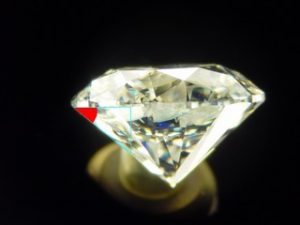
The pavilion angle is a key proportion in diamond cutting, referring to the angle between the girdle plane (the widest part of the diamond) and the pavilion main facets (the facets on the lower half of the diamond). This angle plays a crucial role in determining the diamond’s brilliance, sparkle, and overall visual appeal. A well-cut pavilion angle ensures that light entering the diamond is properly reflected and refracted, resulting in the diamond’s characteristic shine and fire.
Understanding Pavilion Angle and Its Impact on the Diamond
1. What is the Pavilion Angle?
The pavilion angle is the angle formed between the girdle plane and the pavilion facets, which are the large, angled facets located beneath the diamond’s girdle.
This angle controls how light is directed through the diamond, impacting how light is reflected and refracted inside the stone before exiting through the crown (the top portion of the diamond).
Why Pavilion Angle is Crucial for Diamond Quality
1. Light Reflection and Brilliance
The pavilion angle directly affects the diamond’s brilliance, which is the amount of white light that is reflected from the diamond’s facets.
If the pavilion angle is too steep (shallow pavilion), light will pass straight through the bottom of the diamond, resulting in poor light reflection and a loss of brilliance.
Conversely, if the pavilion angle is too shallow, light may not be reflected properly inside the diamond, causing the diamond to appear dull and lacking in sparkle.
A well-angled pavilion helps to direct light back through the top of the diamond, enhancing its brilliance and sparkle.
2. Fire and Dispersion
The pavilion angle also influences the diamond’s fire, or the ability to break up white light into its spectral colors (the rainbow flashes that diamonds are known for).
A correct pavilion angle will allow light to be dispersed in a way that maximizes the diamond’s fire and visual impact, making it more vibrant and colorful. A poorly cut pavilion angle may cause the dispersion to be too weak or distorted, resulting in a less dazzling diamond.
3. Symmetry and Aesthetic Appeal
A well-cut pavilion creates a symmetrical diamond where light is evenly reflected and dispersed from all facets.
Proper symmetry helps the diamond to sparkle evenly from all angles, contributing to a uniform brilliance. Poor pavilion angles can lead to uneven reflections, affecting the diamond’s overall visual appeal.
Ideal Pavilion Angle
The ideal pavilion angle varies slightly based on the diamond shape, but for round brilliant diamonds, the generally accepted ideal pavilion angle is between 40.6° and 41.0°. This range allows the diamond to reflect light efficiently and produce the maximum brilliance and fire.1. Round Brilliant Cut
For round brilliant diamonds, the pavilion angle should ideally be around 40.6° to 41.0°. This range maximizes the diamond’s light return, ensuring the diamond sparkles and reflects light at its best.
If the angle is too steep (over 41.0°), it may cause the diamond to appear dark or dull. If the angle is too shallow (under 40.6°), the diamond may appear washed out, with less light reflection.
2. Other Fancy Cuts
For diamonds with fancy shapes (e.g., emerald, princess, pear, oval), the pavilion angle may vary slightly due to the differences in facet arrangement and proportions. However, the basic principle remains the same: the pavilion angle should be optimized to allow for efficient light reflection and sparkle.
How to Measure the Pavilion Angle
1. GIA and DCLA Grading Reports
Reputable gemological laboratories like the Gemological Institute of America (GIA) and the Diamond Certification Laboratory of Australia (DCLA) provide cut grades that assess a diamond’s proportions, including the pavilion angle.
In a grading report, the pavilion angle will be listed as part of the overall cut quality of the diamond. For example, GIA’s grading system includes a detailed breakdown of the cut grade, which encompasses the pavilion angle, the crown angle, and the overall symmetry of the diamond.
2. Manual Measurement by a Gemologist
A gemologist can manually measure the pavilion angle using precise instruments such as a protractor or optical tools. However, these measurements are typically already included in the official diamond report from grading labs.
Effects of Incorrect Pavilion Angles
1. Too Shallow Pavilion Angle (Low Angle)
If the pavilion angle is too shallow, typically below 40°, light entering the diamond will pass through the bottom of the stone without reflecting back. This results in a loss of brilliance and a flat appearance.
Shallow pavilion angles can also make the diamond look larger than it actually is, but at the cost of visual performance. The diamond may lack the sparkle and fire that buyers typically expect.
2. Too Steep Pavilion Angle (High Angle)
If the pavilion angle is too steep, typically above 41°, the diamond will reflect light poorly, making the diamond look dark and uninteresting.
A steep pavilion angle can cause light to be reflected out of the sides rather than the top of the diamond, which reduces the stone’s overall brilliance and leads to a dead, dark appearance.
3. Symmetry Issues
A poorly cut pavilion may lead to asymmetry, where the facets don’t line up properly. This can cause irregular light reflection, diminishing the diamond’s overall brilliance and sparkle.
How the Pavilion Angle Affects Diamond Value
1. Influence on Cut Quality
The cut grade is one of the most important factors in determining a diamond’s overall value. A well-cut pavilion that optimizes light performance will result in a higher cut grade, which typically translates to a higher value for the diamond.
A poorly proportioned pavilion angle (either too steep or too shallow) can reduce the diamond’s cut grade, making it less valuable in the market.
2. Impact on Aesthetic Appeal
Diamonds with well-cut pavilions tend to be more brilliant and visually stunning, which makes them more desirable to buyers. A diamond with poor pavilion proportions may appear dull, which can lower its perceived value.The pavilion angle is a key aspect of diamond cutting that directly influences the diamond’s brilliance, fire, and overall aesthetic appeal. The ideal pavilion angle allows light to be reflected efficiently through the diamond, contributing to its signature sparkle and vibrant rainbow flashes. A properly proportioned pavilion angle is crucial for ensuring the diamond’s visual impact and maximizing its value. When evaluating a diamond, paying attention to the pavilion angle and ensuring that it falls within the ideal range is essential for selecting a diamond that is both stunning and valuable.
- Pavilion Depth
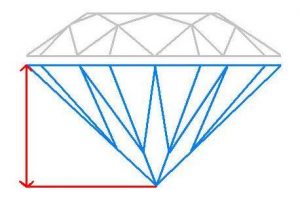
The pavilion depth refers to the vertical distance from the girdle (the widest part of the diamond) to the culet (the point at the bottom of the diamond). This dimension plays a crucial role in a diamond’s light performance, brilliance, and overall appearance. The pavilion depth is an essential component of the diamond’s cut proportions, and its proper measurement ensures the stone’s aesthetic appeal and value.
What is Pavilion Depth?
Pavilion Depth is the distance between the girdle (the widest part of the diamond) and the culet (the tip or point at the bottom of the diamond). This measurement can be expressed either in millimeters or as a percentage of the diamond’s total depth (the measurement from the table to the culet).
In the context of diamond cutting, the pavilion depth is a critical parameter because it directly affects how the diamond handles light. If the pavilion depth is improperly proportioned, it can impact the diamond’s brilliance, fire, and overall symmetry.
How Pavilion Depth Affects a Diamond’s Appearance
1. Light Reflection and Brilliance
The pavilion depth plays a key role in how light is reflected inside the diamond. When light enters the diamond from the top (through the table), it is refracted through the crown (the upper portion) and the pavilion before exiting through the top facets.
If the pavilion depth is too shallow, light will pass through the bottom of the diamond without being adequately reflected, resulting in loss of brilliance.
Conversely, if the pavilion depth is too deep, light may reflect too much inside the diamond, and some light may get lost through the sides, reducing the overall brilliance and causing the diamond to appear dark or dull.
2. Fire and Dispersion
The pavilion depth also influences the fire or dispersion of the diamond, which is the ability to break white light into rainbow flashes. A well-proportioned pavilion depth enhances the diamond’s fire, creating colorful flashes of light as the diamond moves.
A shallow pavilion may not allow the diamond to display its full fire potential, and a deep pavilion may cause excessive dispersion, creating a less refined or washed-out appearance.
3. Diamond Proportions and Symmetry
Proper pavilion depth is essential for achieving a well-proportioned diamond. A diamond with balanced proportions will have optimal symmetry, contributing to uniform brilliance and a more aesthetic appearance.
Diamonds with incorrect pavilion depths (either too shallow or too deep) can have imbalanced proportions, leading to uneven sparkle and a less desirable appearance.
Ideal Pavilion Depth for Diamonds
The ideal pavilion depth depends on the shape of the diamond and the overall proportions of the stone. For round brilliant cut diamonds, the pavilion depth is typically measured as a percentage of the total depth (the overall measurement from the table to the culet).1. Round Brilliant Cut Diamonds
For round brilliant diamonds, the ideal pavilion depth typically falls between 43% and 44% of the total depth of the diamond.
This range ensures the diamond will have the best balance of brilliance and fire, as the pavilion depth will optimize the light reflection and dispersion.
If the pavilion depth is below 43%, the diamond may appear shallow and lack brilliance. If it is above 44%, the diamond may appear too dark or lacking in sparkle.
2. Fancy Shape Diamonds (e.g., Cushion, Princess, Oval)
For diamonds with fancy shapes, the pavilion depth may vary depending on the shape and the overall proportions of the diamond. However, like round diamonds, a well-balanced pavilion depth is essential for optimal light performance.
In general, the ideal pavilion depth for fancy shapes should allow for proper light reflection and brilliance, with variations in pavilion depth based on the individual shape’s design and facet arrangement.
How to Measure Pavilion Depth
1. Using GIA and DCLA Grading Reports
Reputable gemological laboratories like the Gemological Institute of America (GIA) and the Diamond Certification Laboratory of Australia (DCLA) provide detailed cut grades and proportions for diamonds, including the pavilion depth.
The pavilion depth is measured as part of the overall cut proportions and is typically presented as a percentage of the total depth of the diamond. This ensures that buyers are informed about the diamond’s light performance potential.
2. Manual Measurement
A gemologist can manually measure the pavilion depth using precise tools such as a microscope or calipers. However, this measurement is typically included in certified reports from grading organizations like GIA or DCLA, ensuring accuracy and consistency.
Effects of Incorrect Pavilion Depth
1. Too Shallow Pavilion Depth
If the pavilion depth is too shallow (less than 43% for round brilliant diamonds), light will not reflect properly inside the diamond, leading to a loss of brilliance and an overall dull appearance.
Shallow pavilion depths can make the diamond look larger than it actually is, but at the cost of visual performance. The diamond may lack the characteristic sparkle and fire that makes diamonds so captivating.
2. Too Deep Pavilion Depth
If the pavilion depth is too deep (above 44% for round brilliant diamonds), light will be reflected too much inside the diamond and may be lost through the sides. This can lead to a dark appearance and a reduction in the diamond’s brilliance.
Deep pavilion depths can also distort the diamond’s overall proportions, making it appear smaller or less vibrant than it actually is.
Pavilion Depth and Diamond Value
The pavilion depth is a critical factor that influences the cut grade, and therefore, the value of the diamond. Diamonds with properly proportioned pavilion depths tend to have higher brilliance and fire, which makes them more desirable and valuable in the market.1. Influence on Cut Quality
The cut grade is one of the most important factors in determining a diamond’s overall value. A well-proportioned pavilion depth will result in a higher cut grade, which typically translates to a higher price for the diamond.
Diamonds with poorly proportioned pavilions (either too shallow or too deep) will have a lower cut grade, leading to a decrease in value.
2. Impact on Aesthetic Appeal
Diamonds with properly proportioned pavilion depths have uniform brilliance, sparkle, and fire, making them more visually appealing. As a result, they tend to be more valuable to buyers looking for a high-quality diamond.The pavilion depth is a critical component of a diamond’s cut proportions and significantly impacts the diamond’s brilliance, fire, and overall visual appeal. The ideal pavilion depth ensures that light is efficiently reflected and refracted within the diamond, maximizing its sparkle and colorful dispersion. Diamonds with properly proportioned pavilion depths tend to be more brilliant, aesthetically pleasing, and valuable. When evaluating a diamond, paying attention to the pavilion depth, along with other key factors like pavilion angle and symmetry, is essential for selecting a high-quality diamond with optimal light performance and beauty.
- Pavilion Depth Percentage
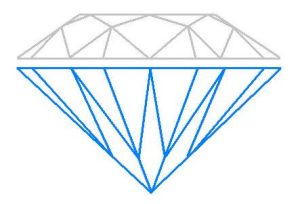
The pavilion depth percentage is a crucial measurement in understanding how well a diamond performs in terms of brilliance and light reflection. It refers to the pavilion depth (the vertical distance from the girdle to the culet) expressed as a percentage of the diameter of the diamond. This proportional measurement plays a significant role in determining how light interacts with the diamond, and its effect on the diamond’s aesthetic appearance and overall quality.
What is Pavilion Depth Percentage?
Pavilion depth percentage is the ratio of the pavilion depth to the diameter of the diamond, calculated as a percentage.
For example, if the pavilion depth is 43% of the total diameter of the diamond, this means that the pavilion depth makes up 43% of the total horizontal width of the diamond.
The percentage is important because it gives an indication of how well the diamond is proportioned. Proper pavilion depth percentage ensures that the diamond maximizes its light performance and visual appeal, contributing to its brilliance and fire.
How Pavilion Depth Percentage Affects Diamond Light Performance
1. Brilliance and Sparkle
The pavilion depth percentage affects how light is reflected inside the diamond. When light enters the diamond, it bounces off the pavilion facets, refracting and dispersing through the crown (the top part of the diamond) and exiting through the table (the flat top surface).
A well-proportioned pavilion depth percentage ensures that light is optimally reflected and refracted, which maximizes the brilliance and sparkle of the diamond. This is the characteristic that gives a diamond its signature fire and life.
2. Nailhead Effect (Too Deep Pavilion)
When the pavilion depth percentage is too high, the diamond’s pavilion becomes too deep, leading to a phenomenon known as the nailhead.
The nailhead occurs when light is trapped inside the pavilion, failing to reflect out of the diamond’s crown, resulting in a dark appearance. This effect can significantly reduce the diamond’s brilliance and visual appeal.
In other words, a too deep pavilion leads to a lack of light return, causing the diamond to look dull and lacking in sparkle.
3. Fish Eye Effect (Too Shallow Pavilion)
On the flip side, when the pavilion depth percentage is too shallow (i.e., the pavilion is too flat), a fish eye effect can occur.
The fish eye is caused by light entering the diamond and reflecting off the flat pavilion in such a way that it creates an unattractive, dark circle near the center of the diamond. The diamond looks flat and lifeless, with reduced sparkle.
A shallow pavilion prevents light from being properly reflected inside the diamond, causing it to appear less vibrant and lacking in brilliance.
Ideal Pavilion Depth Percentage for Round Brilliant Diamonds
For round brilliant cut diamonds, the ideal pavilion depth percentage typically falls within the range of 43% to 44% of the diamond’s diameter.
This range allows for optimal light reflection and refraction, ensuring the diamond achieves maximum brilliance and fire. Within this range, the diamond will appear vibrant and full of life, with a balanced distribution of light and sparkle.
Impact of Pavilion Depth Percentage on Diamond Value
1. Light Performance and Value
Diamonds with properly proportioned pavilion depth percentages are considered to have higher light performance, which enhances their brilliance and fire. As a result, these diamonds are more valuable and sought after by buyers.
Diamonds with poor pavilion depth percentages (either too deep or too shallow) tend to have lower brilliance and reduced visual appeal, which can decrease their market value.
2. Cut Grade and Market Appeal
The pavilion depth percentage is an integral component of the cut grade of a diamond. A diamond with a well-proportioned pavilion typically receives a higher cut grade, which directly impacts its market price.
Buyers often prioritize diamonds with well-proportioned cuts, as they promise a more aesthetic and eye-catching appearance. As a result, diamonds with the right pavilion depth percentage are more likely to command a premium price in the market.
How to Measure Pavilion Depth Percentage
1. Grading Reports
Reputable gemological laboratories like the Gemological Institute of America (GIA) and the Diamond Certification Laboratory of Australia (DCLA) provide detailed grading reports for diamonds, including the pavilion depth percentage.
These reports include measurements for the pavilion depth, total depth, and diameter of the diamond, which allow buyers and gemologists to calculate the pavilion depth percentage accurately.
2. Manual Measurement
A certified gemologist can also measure the pavilion depth percentage manually using specialized tools like a microscope or digital calipers. However, this measurement is typically included in certified grading reports, ensuring accuracy and consistency. - Pavilion Main Facets
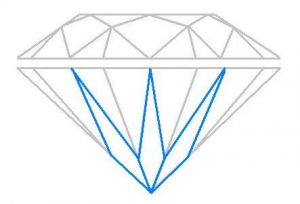
The pavilion main facets are a crucial component of a diamond’s pavilion, contributing significantly to its overall brilliance, symmetry, and light performance. These facets are positioned on the lower half of the diamond, extending from the culet (the tip at the bottom) to the girdle (the widest part of the diamond). The precise arrangement and number of pavilion main facets influence how light interacts with the diamond, ultimately impacting its sparkle, fire, and overall appearance.
What are Pavilion Main Facets?
The pavilion main facets are the large, kite-shaped facets located on the pavilion of the diamond. These facets extend from the culet (the pointy bottom) to the girdle (the widest perimeter of the diamond).
Typically, round brilliant cut diamonds feature 8 pavilion main facets, while fancy shaped diamonds (such as princess, oval, and cushion) may have a different number of pavilion facets depending on their cut and shape. These facets are key to how the diamond handles light and contributes to its overall aesthetic.
Role of Pavilion Main Facets in Diamond Brilliance
1. Light Reflection and Dispersion
The pavilion main facets are responsible for the internal reflection and refraction of light within the diamond. When light enters the diamond from the table (top flat surface), it interacts with the crown and pavilion facets, causing the light to bounce off the facets and return to the viewer’s eye.
The kite shape of the facets allows for optimal light reflection, enhancing the diamond’s brilliance. Well-designed pavilion facets enable the diamond to exhibit maximum fire, with flashes of light reflecting through the crown.
When these facets are properly proportioned and aligned, they direct light in such a way that the diamond sparkles brilliantly. The facets also contribute to the dispersion of light, creating the colorful flashes that diamonds are famous for.
2. Maximizing Brilliance and Fire
The arrangement of the pavilion main facets is designed to maximize the amount of light that enters the diamond, which is then reflected back through the top facets (the crown). This direct interaction between the pavilion and the crown facets enhances the diamond’s overall brilliance and fire.
In a well-cut diamond, the pavilion main facets work in harmony with the crown facets and the table facet, creating a balance that allows for perfect light performance. This leads to the characteristic sparkle and depth seen in high-quality diamonds.
Properly proportioned pavilion facets allow light to reflect more efficiently, contributing to the vibrant appearance and dazzling visual effect of the diamond.
Effect of Pavilion Main Facets on Diamond Proportions and Symmetry
1. Symmetry and Overall Cut Quality
The symmetry of the pavilion main facets is crucial to achieving a well-proportioned diamond. If the facets are unevenly sized or misaligned, it can disrupt the balance of light reflection and refraction, reducing the diamond’s overall brilliance and fire.
A diamond with well-cut, symmetrical pavilion main facets will have superior light performance, and its sparkle will be uniform across the surface. This contributes to its high cut grade and overall quality.
Asymmetrical or poorly cut pavilion facets will reduce the diamond’s visual appeal, making it less desirable and potentially less valuable.
2. Impact on Diamond’s Shape
The pavilion main facets also contribute to the overall shape and outline of the diamond. In round brilliant diamonds, these facets create the characteristic round shape of the stone when viewed from the top.
In fancy shape diamonds, the pavilion main facets contribute to the unique shape of the diamond, whether it’s a princess, cushion, oval, or emerald cut. The number, shape, and arrangement of pavilion facets vary depending on the diamond shape, but all contribute to the overall visual appeal and proportions.
Pavilion Main Facets and Diamond Value
1. Cut Grade and Light Performance
The quality and symmetry of the pavilion main facets are essential to the cut grade of the diamond. Diamonds with well-cut facets tend to receive higher cut grades, as they exhibit better brilliance, fire, and overall visual appeal.
The cut grade is one of the most important factors in determining a diamond’s value, as it directly impacts the diamond’s aesthetic quality. A diamond with well-aligned pavilion main facets will have higher light performance, making it more desirable to buyers.
2. Aesthetic Appeal
The pavilion main facets are central to the beauty and aesthetic appeal of the diamond. When these facets are correctly cut and aligned, they enhance the diamond’s ability to reflect light, producing vibrant flashes and sparkling effects. This makes the diamond more attractive and valuable in the eyes of buyers.
Understanding Pavilion Main Facet Proportions
1. Ideal Pavilion Depth and Angle
The proportions of the pavilion main facets are closely tied to the pavilion depth and pavilion angle. Properly proportioned facets are critical for achieving optimal light reflection, which is why pavilion depth and pavilion angle are key factors in determining how well the facets will perform.
The ideal pavilion depth percentage typically ranges between 43% to 44% for round brilliant diamonds, and the pavilion angle should generally be between 40.6° and 41.8° for optimal brilliance.
Under-proportioned or over-proportioned pavilion main facets (such as an overly deep pavilion or a shallow pavilion) can cause a reduction in the diamond’s sparkle and can result in undesirable effects like a nailhead or fish eye.
2. Variations in Fancy Cut Diamonds
While round brilliant cut diamonds typically feature 8 pavilion main facets, other diamond shapes have different facet arrangements that are tailored to their unique geometry.
Princess cut diamonds generally have 4 pavilion main facets.
Cushion and radiant cuts feature a combination of pavilion facets that vary in number and shape to match their specific cut characteristics.The Importance of Pavilion Main Facets
The pavilion main facets are an integral part of a diamond’s cut, and they significantly influence the diamond’s brilliance, fire, and overall appearance. These kite-shaped facets are responsible for reflecting and refracting light within the diamond, contributing to its characteristic sparkle and vibrancy. Properly proportioned and symmetrical pavilion facets result in a diamond that exhibits optimal light performance and has a high-quality appearance.For diamonds with excellent cut grades, these facets work in harmony with the crown facets and table facet to create a beautiful and eye-catching diamond that is desirable to buyers. Understanding the role of the pavilion main facets and their symmetry, proportions, and alignment is essential when assessing a diamond’s value, quality, and visual appeal.
- Pear Cut

The pear cut, also known as the teardrop cut, is a popular and elegant diamond shape that combines the round brilliance of a brilliant cut with the graceful tapering of a marquise. This stunning shape features a rounded head that gradually tapers to a pointed tip, resembling the form of a teardrop or pear. Known for its unique shape and brilliant sparkle, the pear cut has remained a timeless choice for engagement rings, pendants, and earrings, appealing to those who appreciate a blend of classic elegance and modern flair.
What is a Pear Cut Diamond?
A pear cut diamond is a hybrid shape, combining the characteristics of the round brilliant cut and the marquise cut. It features a rounded top, or head, and a pointed bottom, creating the signature teardrop shape.
The facets of a pear cut diamond are arranged in a similar manner to those in a round brilliant cut, ensuring it displays the same brilliance and fire. The rounded portion of the diamond reflects light from all angles, while the tapering point contributes to the diamond’s overall light performance.
Key Characteristics of the Pear Cut
1. Shape and Symmetry
The pear cut is recognized for its distinctive tear-drop shape, with a rounded, curved top and a pointed bottom. This shape combines the round brilliance of the classic round diamond with the elongated appearance of the marquise.
The symmetry of a pear cut diamond is essential for its visual appeal. A well-proportioned pear cut will have a uniform curve from the rounded head to the tip, with the point centered to give it a balanced and harmonious look.
The length-to-width ratio of the pear cut can vary depending on personal preference. Pear cuts with a longer shape appear more elongated, while wider pear cuts have a fuller, more rounded appearance. The ideal length-to-width ratio for a pear-shaped diamond typically ranges from 1.45 to 1.75, with the most popular being around 1.5. This proportion ensures a well-balanced and pleasing appearance.
2. Facet Arrangement and Brilliance
A pear cut diamond features 58 facets (or more), similar to the round brilliant cut. These facets are arranged in a way that maximizes the diamond’s ability to reflect light, giving it exceptional brilliance, fire, and sparkle.
The crown (top portion) of the diamond features the table facet, while the pavilion (bottom portion) contains the main facets. These facets are angled and arranged to enhance light performance, ensuring the diamond sparkles from every angle.
A well-cut pear-shaped diamond will have bright flashes of light that seem to emanate from its center, thanks to the diamond’s symmetry and faceting.
Pear Cut Diamond – Light Performance and Sparkle
1. Brilliant Light Reflection
The pear cut is designed to offer excellent light reflection, thanks to its brilliant facet arrangement. The light enters the diamond through the table, reflecting off the facets of the crown and pavilion before exiting the diamond.
This process creates the sparkle and fire that makes a pear cut diamond so captivating. Well-cut pear diamonds display an exceptional level of brilliance and are particularly vibrant under both natural light and artificial light.
2. Unique Sparkle and Fire
The pear shape’s tapered point causes the diamond to display flashes of colorful fire—the dispersion of light into its spectral colors—while the rounded head creates a uniform and pleasing sparkle. This contrast between the round portion and the pointed tip gives the pear cut diamond a unique visual appeal.
Pear cut diamonds are especially renowned for their flashes of color, which makes them stand out from other diamond shapes. When properly cut, the facets will allow light to travel through the diamond in a way that creates beautiful scintillation and vivid flashes.
The Pear Cut – Ideal for Different Jewelry Styles
1. Engagement Rings
The pear cut diamond is a popular choice for engagement rings because it offers a distinctive and romantic appearance. Its teardrop shape symbolizes eternal love and tears of joy, making it a fitting choice for couples looking for a symbol of their love story.
The elongated form of the pear cut can give the finger a more slender appearance, making it a flattering choice for those seeking a ring that adds an elegant touch. Additionally, the pointed tip of the pear cut can be oriented upwards or downwards, allowing for a customizable look.
The pear cut diamond works well in a variety of settings, including solitaire designs, halo settings, and three-stone rings, allowing for flexibility in personalizing the ring.
2. Pendants and Earrings
The pear shape is also a favored choice for pendants and earrings because it offers an elegant and timeless appeal. A pear-shaped diamond pendant drapes beautifully along the neck, while pear-shaped earrings elongate the appearance of the face, drawing attention to the wearer’s features.
Halo settings and side stone accents are often used to complement a pear-shaped diamond in pendants and earrings, enhancing the overall brilliance of the piece.
Pear Cut Diamond – Choosing the Right One
1. Cut Quality
The cut quality of a pear-shaped diamond is essential for maximizing its brilliance and sparkle. A well-cut pear diamond will have precise proportions, even symmetry, and expertly aligned facets to ensure optimal light performance.
To assess the cut quality, it’s important to consider grading reports from reputable gemological laboratories, such as the GIA or DCLA, which evaluate the diamond’s cut, polish, and symmetry.
2. Color and Clarity
Like other diamond shapes, the color and clarity of a pear-shaped diamond should be considered when selecting the perfect stone. Higher color grades (D-F) will ensure that the diamond remains colorless and does not show any noticeable yellow or brown hues, while clarity determines the presence of internal or external inclusions.
Pear-shaped diamonds may also have a larger surface area compared to round diamonds, which may make inclusions more visible. It’s important to choose a diamond with a clarity grade that minimizes any noticeable blemishes or inclusions.
Tips for Selecting the Perfect Pear Cut Diamond
Symmetry: Ensure that the pear cut diamond has excellent symmetry. The pointed tip should be centered and even, and the curved part should be smooth and symmetrical.
Length-to-Width Ratio: Choose a length-to-width ratio that suits your preference. Pear cut diamonds with a ratio of about 1.5 are typically balanced, while longer shapes will appear more elongated, and wider shapes will appear fuller.
Setting Style: Consider how the pear-shaped diamond will be set. The orientation of the pointed tip can be customized to either point upward or downward, allowing for a unique and personal style.The Allure of the Pear Cut
The pear cut diamond is a versatile and elegant choice for those who desire a distinctive and timeless diamond shape. With its graceful teardrop silhouette, the pear cut combines the brilliance of the round cut with the elongated form of the marquise, creating a captivating sparkle that makes it a standout piece in any jewelry collection. Whether used in engagement rings, pendants, or earrings, the pear cut is known for its unique beauty and classic appeal that never goes out of style. - Phosphorescence
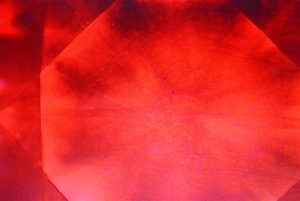
Phosphorescence is a rare but fascinating phenomenon observed in some diamonds, where the diamond continues to glow in the dark for a brief period after the light source is removed. This occurs due to the absorption and subsequent re-emission of energy in the form of light. Unlike fluorescence, which ceases once the light source is removed, phosphorescence can cause the diamond to emit light for a short period, creating a striking and ethereal effect.
Understanding Phosphorescence in Diamonds
Phosphorescence occurs when certain materials, such as diamonds, absorb energy from a light source and then release that energy over time in the form of light. In the case of diamonds, it’s often a faint glow that can last anywhere from a few seconds to several minutes after exposure to light.
The glow is typically greenish-blue or bluish-white in color, though in some cases, it may appear pink or yellow. This light emission comes from the diamond’s internal structure, where the energy absorbed from the light source excites electrons in the crystal lattice, causing them to become “trapped.” Once the light source is removed, these trapped electrons slowly release the absorbed energy, which results in the glow.
Phosphorescence vs. Fluorescence: Key Differences
While phosphorescence and fluorescence are similar in that they both involve the emission of light after exposure to UV or visible light, there are distinct differences between the two phenomena:Fluorescence: Fluorescent diamonds emit visible light immediately when exposed to ultraviolet (UV) light and stop glowing once the UV light is removed. The effect is usually instantaneous and relatively short-lived. Fluorescence is more common in diamonds and is most often seen as a blue glow.
Phosphorescence: Unlike fluorescence, phosphorescent diamonds continue to emit light for a period of time after the light source is removed, creating a glow-in-the-dark effect. Phosphorescence is much rarer and typically found in synthetic diamonds or diamonds with certain trace elements, though it can occasionally be observed in natural diamonds.
Phosphorescence in Synthetic Diamonds
Phosphorescence is more common in synthetic diamonds than in natural diamonds, particularly in diamonds created through the High Pressure High Temperature (HPHT) or Chemical Vapor Deposition (CVD) methods. These diamonds may exhibit phosphorescence due to the specific trace elements or impurities introduced during their creation.
The phosphorescent glow in synthetic diamonds is often due to the presence of certain nitrogen or boron impurities in the crystal lattice. These impurities can cause the diamond to absorb light and then release it as phosphorescent glow after the light source is removed.
Phosphorescence in Natural Diamonds
Phosphorescence is rare in natural diamonds, but it can still occur under specific conditions. In some rare cases, natural diamonds may exhibit phosphorescence due to the presence of impurities or defects in the crystal structure, although the phenomenon is typically less pronounced than in synthetic diamonds.
The glowing effect in natural diamonds is often subtle and may not be immediately noticeable without proper testing in a darkened environment. When observed, the phosphorescence in natural diamonds is typically weaker and lasts for a shorter time compared to synthetic diamonds.
Factors That Influence Phosphorescence in Diamonds
Several factors can influence the intensity and duration of phosphorescence in diamonds:1. Type of Diamond (Natural vs. Synthetic)
Synthetic diamonds are more likely to exhibit phosphorescence, as certain impurities or processes used during their creation can result in more significant light emission after exposure to light.
Natural diamonds, while capable of phosphorescence, rarely exhibit this phenomenon, and when they do, the effect is usually less noticeable or short-lived.
2. Trace Elements and Impurities
Nitrogen: Some diamonds that have higher nitrogen content in their crystal structure are more likely to exhibit phosphorescence. Nitrogen can create color centers in the diamond, which can store energy and release it as a glow after the light is removed.
Boron: Boron impurities, which are responsible for the blue color in some diamonds, can also contribute to phosphorescence. However, the effect is more pronounced in synthetic diamonds where boron is more prevalent.
Other Impurities: Various other impurities or defects in the diamond structure can create centers that facilitate phosphorescence, though these occurrences are generally rare in natural diamonds.
3. Exposure to Light
The intensity of the phosphorescent glow depends on the amount of light the diamond is exposed to and the duration of exposure. A stronger or longer exposure will result in a more noticeable glow once the light source is removed.
The diamond’s cut and clarity can also influence how light interacts with the crystal structure and how effectively the diamond absorbs and re-emits energy.
Phosphorescence in Jewelry
While fluorescent diamonds are often sought after for their unique glow under UV light, phosphorescent diamonds are much rarer and can be seen as a unique and intriguing feature in a diamond. However, phosphorescence is not typically a desirable trait for most buyers because it is rare, and its glow can sometimes diminish the clarity or overall visual appeal of the diamond when viewed in daylight.For collectors and enthusiasts, phosphorescence can be a fascinating and rare characteristic to observe, though it’s not typically factored into the grading or pricing of diamonds. When it does occur, it is generally not used as a selling point unless it is present in a synthetic diamond where the effect is more pronounced.
The Glowing Diamond Mystery
Phosphorescence in diamonds is a captivating but rare phenomenon that can occur when a diamond continues to glow in the dark after exposure to light. While it is more commonly associated with synthetic diamonds, certain natural diamonds can also exhibit this glowing effect, often due to specific impurities or defects in the crystal structure. Whether seen in synthetic or natural diamonds, phosphorescence adds an intriguing layer to the already fascinating world of diamonds, providing an additional dimension to their natural beauty. - Pink Diamond

A coloured diamond with a natural pink body colour. Pink must be the predominant colour, but it may be modified by shades of purple, orange, and yellow. The colour in natural pink diamonds is created by irregular crystal structure. Some pink coloured diamonds with sufficient saturation fall into the valuable fancy pink colour category of diamonds.
A pink diamond is a rare and highly sought-after coloured diamond that exhibits a natural pink body colour. To be classified as a pink diamond, pink must be the predominant hue, though it may be modified by secondary tones such as purple, orange, or yellow.
Unlike most coloured diamonds, which owe their hues to chemical impurities, the captivating colour of natural pink diamonds is attributed to distortions in their crystal lattice structure. These distortions, formed under immense pressure during the diamond’s geological formation, alter the way light interacts with the stone, producing its signature pink hue.
Pink diamonds vary in intensity, ranging from delicate pastel shades to deep, vivid pinks. Those with higher colour saturation are classified as Fancy Pink diamonds, a designation that significantly enhances their value. The most desirable pink diamonds display pure, strong pink tones with minimal secondary colours.
These exquisite gems are among the rarest diamonds in the world, with the finest specimens historically sourced from the Argyle mine in Australia, which ceased operations in 2020. The mine’s closure has further increased the rarity and value of high-quality pink diamonds. Today, they remain a prized choice for collectors and investors, often fetching record-breaking prices at auctions.
- Pinpoints
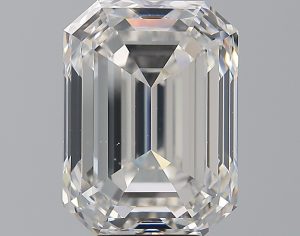
Pinpoints are extremely small diamond crystal inclusions that are typically too tiny to distinguish their individual shapes, even under magnification. When viewed under 10x magnification, a single pinpoint appears as a minute, white or black “dot” within the diamond. While a single pinpoint is often insignificant and may not affect a diamond’s overall clarity or brilliance, multiple pinpoints grouped together can form a cloud—a hazy or milky area within the diamond that can impact its transparency and light performance.
These inclusions are a natural part of a diamond’s formation process and are commonly found in many diamonds. Depending on their number, size, and location, pinpoints can have varying effects on a diamond’s clarity grade. In some cases, when they are sparsely distributed, they have little to no visible impact. However, if they are densely clustered, forming a significant cloud, they may lower the diamond’s clarity rating and slightly reduce its brilliance by affecting how light passes through the stone.
Pinpoints are one of the many inclusions that gemologists assess when grading diamonds, and they are often documented on a diamond’s grading report issued by reputable gemological laboratories such as the GIA (Gemological Institute of America) or DCLA (Diamond Certification Laboratory of Australia).
- Pit
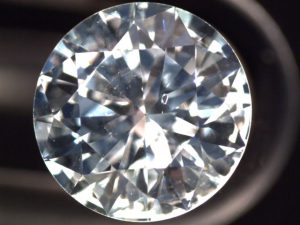
A pit is a type of diamond blemish that appears as a tiny surface indentation or opening on the diamond’s exterior. These minute imperfections can be caused by natural formation processes, the cutting and polishing process, or general wear and tear over time. Pits are typically small and may require 10x magnification to be seen clearly, though larger pits can sometimes be visible to the naked eye.
When pits are larger and deeper, they are classified as cavities, which can have a more noticeable impact on a diamond’s clarity and durability. Pits and cavities are usually found on the table or facet junctions of a diamond, where they may affect the overall finish of the stone.
Pits can influence a diamond’s polish grade, as they interrupt the smoothness of the surface. While minor pits may not significantly impact a diamond’s appearance or value, excessive or deep pits can detract from its brilliance and make the stone more vulnerable to dirt accumulation or further damage.
In professional diamond grading reports from laboratories like the GIA or DCLA, pits are noted as part of the stone’s clarity characteristics. Jewelers and diamond cutters may attempt to minimize the visibility of pits through careful polishing, though in some cases, deep pits or cavities may require minor re-cutting to improve the diamond’s overall finish.
- Pitted Facet
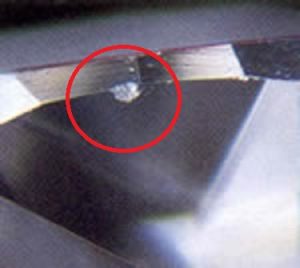
A pitted facet is a diamond facet that contains multiple tiny surface pits, giving it a rough or uneven texture. These pits are small indentations or openings that can occur due to natural formation processes, cutting and polishing imperfections, or general wear over time. While individual pits may be microscopic and require 10x magnification to be seen, a pitted facet has numerous pits concentrated in one area, making the blemish more noticeable.
Impact on Diamond Quality
Pitted facets affect the polish grade of a diamond, as they interrupt the smoothness and reflectivity of the surface. Since polish is a key factor in how a diamond interacts with light, excessive pitting can slightly diminish the stone’s brilliance and sparkle.The severity of a pitted facet depends on the number and depth of the pits:
Minor pitting may have little to no visible impact and may only be noted in a diamond grading report.
Moderate to severe pitting can affect the diamond’s overall finish and may lower its polish grade, making the blemish more apparent under magnification.
Causes and Solutions
Pitted facets can occur naturally during the diamond’s crystallization process, but they may also be caused by:The diamond cutting and polishing process, if small inclusions break away from the surface.
Wear and tear over time, especially if the diamond is exposed to harsh conditions or abrasive materials.
While minor pitting is common and often does not require intervention, severe pitting can sometimes be improved through re-polishing by a professional diamond cutter. However, excessive re-polishing may result in weight loss, so the decision to re-cut or polish should be carefully considered.In professional diamond grading reports from laboratories such as GIA or DCLA, a pitted facet is typically recorded under clarity characteristics and assessed as part of the stone’s overall polish grade.
- Plotting Diagram or Plot
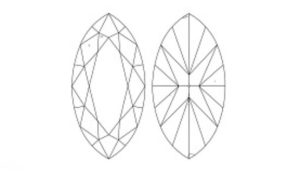
A plotting diagram, also referred to as a “plot”, is a detailed visual representation of a diamond’s inclusions and blemishes. It is included in a diamond’s grading report and serves as a unique “fingerprint” of the stone, helping to identify and distinguish it from others.
Purpose and Importance
The plotting diagram illustrates the approximate size, location, and type of internal inclusions and external blemishes present in the diamond. Since no two diamonds have the exact same inclusion pattern, a plotting diagram provides a permanent record of a diamond’s unique characteristics. It is primarily used for:Identification – Ensuring that the diamond matches its grading certificate.
Verification – Helping gemologists and jewelers confirm the stone’s authenticity.
Security – Assisting in tracking lost or stolen diamonds.
How It Works
A plotting diagram typically consists of two diagrammatic views of the diamond:Crown View (Top-Down Perspective) – Shows inclusions and blemishes on the top portion of the diamond.
Pavilion View (Bottom-Up Perspective) – Displays inclusions found on the lower portion of the stone.
Standardized symbols and colour codes are used to indicate different types of inclusions and blemishes. For example:Red Marks – Represent internal inclusions such as pinpoints, feathers, or clouds.
Green Marks – Represent external blemishes such as scratches, pits, or polish lines.
Black Marks – May be used to indicate laser treatments or additional clarity enhancements.
Where It Is Used
Plotting diagrams are an essential component of diamond grading reports issued by reputable gemological laboratories such as:GIA (Gemological Institute of America)
DCLA (Diamond Certification Laboratory of Australia)
HRD (Hoge Raad voor Diamant – Diamond High Council)
IGI (International Gemological Institute)
Limitations and Considerations
The diagram is an approximate representation, meaning it does not show the actual size or exact shape of inclusions.
Not all clarity characteristics are necessarily plotted—some labs omit very minor inclusions that do not affect the diamond’s clarity grade.
Certain diamonds, particularly those with very high clarity grades (e.g., IF – Internally Flawless), may have no markings at all on the diagram.
A plotting diagram is a crucial tool for identifying and evaluating a diamond, offering a visual roadmap of its clarity characteristics while ensuring transparency in the diamond grading process. - Point

In the diamond industry, a point is a unit of weight used to measure diamonds and other gemstones. One point is equal to one hundredth (1/100) of a carat, or 0.01 carats.
Understanding Points in Diamond Weight
Diamonds are weighed in carats (ct), with each carat divided into 100 points. This system allows for precise measurements, especially for smaller diamonds.For example:
A 15-point diamond weighs 0.15 carats and is sometimes referred to as a “fifteen-pointer.”
A 50-point diamond weighs 0.50 carats, also called a “half-carat” diamond.
A 100-point diamond equals 1.00 carat, making it a one-carat diamond.
Why Points Matter
Precision – Points allow for highly accurate diamond weight measurement, especially for small diamonds where even minor differences in weight can affect value.
Pricing – Since diamond prices are calculated per carat, even a small difference in weight (e.g., 0.49 ct vs. 0.50 ct) can significantly impact the price.
Common Usage – Jewelers and gemologists frequently use the term “points” when referring to diamonds under one carat, as it simplifies communication of weight.
Example Diamond Sizes in Points
Points Carats Common Name
10 pts 0.10 ct Ten-pointer
25 pts 0.25 ct Quarter-carat
50 pts 0.50 ct Half-carat
75 pts 0.75 ct Three-quarter carat
100 pts 1.00 ct One-carat
While points are commonly used for diamonds below 1.00 carat, larger diamonds are generally described in carats rather than points (e.g., a 1.25-carat diamond rather than a 125-pointer).The point system is an essential part of diamond grading and pricing, providing precise measurements that ensure accuracy in weight calculation. Whether buying or selling a diamond, understanding points can help in making informed decisions about size, value, and pricing.
- Polish Grade
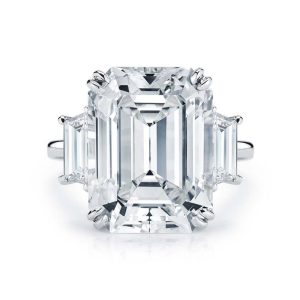
Qualitative analysis of the overall surface condition of a diamond. The quality of polish is determined by the care put in by a polisher when finishing a diamond, and is important to the brilliance and scintillation given off by a diamond.
The polish grade of a diamond is a qualitative assessment of the overall surface condition of the stone. It measures how smoothly and precisely a diamond’s facets have been finished by the polisher. A high polish grade is essential in ensuring that light enters and exits the diamond efficiently, enhancing its brilliance (brightness), fire (dispersion of light into colors), and scintillation (sparkle).
How Polish Grade is Determined
A diamond’s polish grade is evaluated under 10x magnification by gemologists at leading grading laboratories such as the GIA (Gemological Institute of America) or DCLA (Diamond Certification Laboratory of Australia). The grading considers factors such as:Surface quality – The smoothness and refinement of each facet.
Presence of polish lines – Fine parallel lines left from the cutting and polishing process.
Pits and nicks – Small surface indentations or abrasions.
Burn marks – Whitish hazy areas caused by excessive heat from polishing.
Luster – The overall shine and reflectivity of the diamond’s surface.
Polish Grade Scale
The GIA and other reputable labs use a five-grade scale to assess polish quality:Excellent (EX) – No polish imperfections visible under 10x magnification. Light interacts perfectly with the diamond’s facets, maximizing brilliance and fire.
Very Good (VG) – Minute polish imperfections that are extremely difficult to detect and do not impact the diamond’s appearance.
Good (G) – Minor polish flaws that may slightly affect the diamond’s brilliance but are not noticeable to the naked eye.
Fair (F) – Noticeable polish issues that can impact light reflection, causing a slight dulling effect.
Poor (P) – Significant polish defects that visibly affect brilliance and may make the diamond appear hazy or lifeless.
Why Polish Matters
Affects Light Performance – A poorly polished diamond can have reduced brilliance and sparkle due to surface imperfections that interfere with light transmission.
Influences Value – Diamonds with Excellent or Very Good polish grades are more desirable and valuable than those with Fair or Poor grades.
Durability – A well-polished diamond is less prone to surface damage, while rough or poorly finished areas can attract dirt and scratches.The polish grade is a crucial factor in a diamond’s overall beauty and value. When selecting a diamond, a grade of Excellent or Very Good is recommended to ensure optimal light performance. Although polish imperfections are usually minor, a well-polished surface enhances the brilliance, fire, and longevity of the diamond.
- Polished Girdle
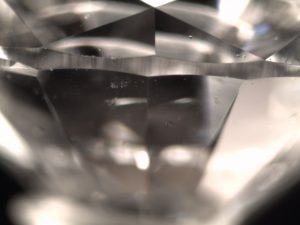
A polished girdle refers to a diamond’s girdle—the narrow band that encircles the stone—being fully polished, smooth, and transparent rather than frosted or faceted. This means the girdle has undergone a polishing process to create a highly reflective and clear surface, free from any roughness or granularity.
Characteristics of a Polished Girdle
Smooth and Glassy Appearance – A polished girdle lacks the matte or granular texture found in bruted girdles and does not have additional facets like a faceted girdle.
Common in Step-Cut Diamonds – Emerald-cut and baguette-cut diamonds typically feature polished girdles to complement their sleek, open facet structures.
Less Common in Round Brilliant Cuts – While most brilliant-cut diamonds have faceted or slightly bruted girdles, some high-quality stones may also have polished girdles.
Advantages of a Polished Girdle
Enhances Transparency – A polished girdle allows light to pass through more efficiently, reducing light obstruction at the girdle edge.
Aesthetically Appealing – Particularly in step-cut diamonds, a polished girdle enhances the overall sleekness of the stone.
Eliminates Roughness – A fully polished girdle is less prone to accumulating dirt and oil compared to a bruted girdle.
Potential Considerations
Visibility of Inclusions – Since a polished girdle is transparent, any inclusions near the girdle may be more visible compared to a bruted or faceted girdle, which can help obscure them.
Durability – While a polished girdle itself does not weaken a diamond, it lacks the additional structural reinforcement that some faceted girdles provide.
Polished Girdle vs. Other Girdle Types
Girdle Type Description Common in
Polished Girdle Smooth, highly polished, transparent Emerald cut, baguette cut, some brilliant cuts
Faceted Girdle Small facets added to improve brilliance and minimize reflection loss Most round brilliant and fancy-cut diamonds
Bruted (Frosted) Girdle Matte, grainy, unpolished texture left from bruting process Some older or vintage diamonds
A polished girdle is a distinguishing feature in step-cut diamonds, contributing to their sleek, elegant appearance. While less common in brilliant-cut diamonds, some high-quality stones feature a polished girdle for enhanced transparency and refinement. Whether a diamond has a polished, faceted, or bruted girdle, the choice often depends on cut style, personal preference, and how the diamond interacts with light. - Princess Cut
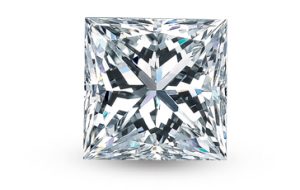
The princess cut is a popular diamond shape known for its sharp, square or rectangular outline and exceptional brilliance. It is a modern, geometric cut that combines elements of both the brilliant cut and the step cut, offering a perfect balance of sparkle and elegance.
Characteristics of the Princess Cut
Shape – Square or slightly rectangular, with sharp, uncut corners.
Facet Pattern – A mix of brilliant and step-cut faceting, designed to maximize brilliance and fire.
Number of Facets – Typically ranges from 50 to 58 facets, depending on the specific design.
Cut Style – Modified brilliant cut with a pyramid-like structure when viewed from the side.
Brilliance and Fire
Despite its angular shape, the princess cut rivals the round brilliant cut in terms of sparkle. Its unique chevron faceting pattern helps to reflect and disperse light, creating excellent fire and brilliance.Pros and Cons of the Princess Cut
Advantages:High brilliance – Offers a stunning level of sparkle, second only to the round brilliant cut.
Modern and elegant look – The sharp, geometric style suits contemporary engagement ring designs.
More affordable per carat – Compared to round diamonds, princess cuts retain more rough diamond material, making them more cost-effective.
Considerations:Sharp corners are vulnerable – Unlike round diamonds, princess cuts have pointed corners that can be prone to chipping if not properly protected by prongs.
Color and clarity are more visible – Due to its faceting style, lower clarity and color grades may be more noticeable, requiring careful selection.
Best Settings for Princess Cut Diamonds
Prong Setting – A four-prong or V-prong setting helps protect the delicate corners.
Bezel Setting – Offers maximum protection by encasing the edges in metal.
Halo Setting – Surrounds the princess cut with smaller diamonds, enhancing brilliance.
Channel Setting – Ideal for wedding bands or side stones, securing the diamond with a sleek, modern look.
Princess Cut vs. Other Cuts
Cut Style Shape Brilliance Best Feature
Princess Cut Square/Rectangular High Modern brilliance with sharp angles
Round Brilliant Circular Very High Maximum sparkle and fire
Emerald Cut Rectangular Moderate Elegant step-cut clarity
Cushion Cut Square/Rounded Corners High Soft, vintage appealThe princess cut is a timeless and sophisticated diamond shape that offers exceptional brilliance in a modern, geometric form. Whether used in engagement rings or fine jewelry, it provides a bold yet elegant alternative to traditional round diamonds, combining beauty, affordability, and brilliance in one striking cut.
- Proportion Grade
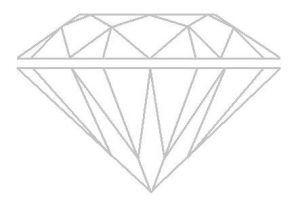
The proportion grade is a qualitative assessment of the overall proportions of a round brilliant cut diamond. It evaluates how well the diamond’s dimensions, angles, and facet arrangements are balanced to maximize brilliance, fire, and scintillation.
Why Proportions Matter
The way a diamond is cut significantly impacts its light performance. If the proportions are too shallow or too deep, light may escape through the sides or bottom of the diamond rather than reflecting back to the viewer, reducing its brilliance. The ideal proportion grade ensures that the diamond reflects and refracts light efficiently, creating maximum sparkle.How Proportion Grade is Determined
For round brilliant cut diamonds, proportion grading is based on several key measurements:Table Percentage – The size of the top facet (table) relative to the total width of the diamond.
Depth Percentage – The total depth of the diamond (from table to culet) relative to its width.
Crown Angle – The angle between the table and the crown facets, affecting light dispersion (fire).
Pavilion Angle – The angle between the pavilion facets and the girdle, influencing light return.
Girdle Thickness – Affects durability and light performance.
Culet Size – Affects light leakage and appearance.
Proportion Grades in Round Brilliant Diamonds
Grading laboratories, such as the GIA (Gemological Institute of America), categorize proportion grades into different levels:Excellent (EX) – Ideal proportions for optimal brilliance, fire, and scintillation. Light is perfectly reflected, creating a highly desirable sparkle.
Very Good (VG) – Slight variations in proportions that still allow excellent light performance, with minimal impact on brilliance.
Good (G) – Noticeable proportion variations that may result in light leakage, reducing the overall brightness.
Fair (F) – Unbalanced proportions causing significant light loss, making the diamond appear dull or lifeless.
Poor (P) – Severe proportion flaws leading to excessive light leakage, drastically affecting brilliance and beauty.
Proportion Grading for Fancy-Shaped Diamonds
Unlike round brilliant cut diamonds, fancy-shaped diamonds (e.g., princess, cushion, oval, emerald) do not receive a proportion grade. This is because there is no universal standard for the best proportions in fancy shapes—each shape has unique visual and performance characteristics that cannot be judged by a single set of criteria. Instead, fancy shapes are evaluated based on symmetry, polish, and overall cut quality.Ideal Proportions for Round Brilliant Diamonds
While exact measurements may vary slightly, the following proportions are considered ideal for maximizing brilliance in a round brilliant cut diamond:Table Size: 53%–58% of the diamond’s total width
Total Depth: 59%–63%
Crown Angle: 34°–35°
Pavilion Angle: 40.6°–41°
Girdle Thickness: Thin to Medium
Culet: None or Very SmallThe proportion grade is a critical factor in determining a round brilliant cut diamond’s overall light performance and beauty. Diamonds with Excellent or Very Good proportion grades offer superior brilliance, making them highly desirable. While fancy-shaped diamonds are not proportion graded, their individual cut quality should still be carefully evaluated to ensure maximum visual appeal.
- Proportions
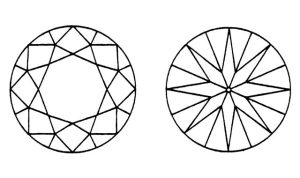
In the context of diamond grading, proportions refer to the relationship between the dimensions and angles of a finished diamond. These elements play a crucial role in how well the diamond performs in terms of brilliance (brightness), fire (color dispersion), and scintillation (sparkle). The ideal proportions ensure that light enters the diamond, reflects off the internal facets, and exits in a way that maximizes the stone’s visual appeal.
Key Proportions in Diamond Grading
Several specific proportions are evaluated to determine how efficiently the diamond handles light and affects its overall appearance. These include:Table Size
Definition: The table is the flat, top facet of the diamond. The table size is the percentage of the diamond’s overall width that the table occupies.
Importance: A table that is too large or too small can affect how light enters the diamond, potentially reducing the amount of sparkle and brilliance. The ideal table size helps balance light reflection and refraction for optimal sparkle.
Recommended Range: For a round brilliant cut, a table size of around 53%–58% is considered ideal.
Depth PercentageDefinition: The depth of a diamond is the measurement from the table to the culet (the tip at the bottom of the diamond). The depth percentage is calculated by dividing the diamond’s depth by its diameter and multiplying by 100.
Importance: The depth affects how well light travels through the diamond. A shallow depth can cause light to leak from the bottom, while a deep depth can prevent light from reflecting fully.
Recommended Range: The ideal depth percentage for a round brilliant cut diamond is generally 59%–63%.
Crown AngleDefinition: The crown angle is the angle between the diamond’s crown (the upper portion above the girdle) and the table.
Importance: The crown angle influences the diamond’s ability to reflect light and create fire (colorful flashes of light). If the angle is too steep or too shallow, light performance is diminished.
Recommended Range: An ideal crown angle for a round brilliant diamond is typically 34°–35°.
Pavilion AngleDefinition: The pavilion angle is the angle between the pavilion facets (the lower part of the diamond) and the girdle (the diamond’s outer edge).
Importance: The pavilion angle has a direct effect on light return. If the pavilion angle is too shallow or steep, light may escape through the bottom of the diamond, reducing sparkle.
Recommended Range: An ideal pavilion angle for a round brilliant diamond is typically around 40.6°–41°.
Girdle ThicknessDefinition: The girdle is the widest part of a diamond, forming a boundary between the crown and pavilion. Girdle thickness refers to how thick or thin the girdle is.
Importance: The girdle’s thickness affects the durability and overall symmetry of the diamond. A girdle that is too thick can make the diamond appear smaller, while one that is too thin may make the diamond more susceptible to damage.
Recommended Range: A thin to medium girdle is often ideal for balance and durability.
Culet SizeDefinition: The culet is the tiny facet at the bottom of the diamond, located at the tip of the pavilion. Culet size refers to the size of this facet.
Importance: A large culet can cause light leakage and affect the diamond’s appearance by making it look less bright and less crisp. A smaller or no culet is often preferred for optimal light performance.
Recommended Range: A no culet or very small culet is usually ideal.
Why Proportions Matter
The proportions of a diamond directly influence its light performance and visual appeal. When the proportions are balanced, light enters the diamond, bounces off its internal facets, and exits to create maximum sparkle and fire.Maximized Brilliance – Proper proportions allow for better internal reflection, resulting in a more vibrant and brilliant diamond.
Enhanced Fire – Well-balanced proportions lead to more effective dispersion of light into the spectrum of colors, creating a diamond with bright flashes of color.
Improved Scintillation – Good proportions enhance the sparkle or scintillation, the flashes of light that occur as the diamond moves.
Proportions in Fancy-Shaped Diamonds
While proportions are crucial for round brilliant cut diamonds, fancy-shaped diamonds (e.g., princess, emerald, oval, pear) do not have standardized proportions. Instead, their light performance is assessed based on symmetry and cut quality. Each shape has unique visual characteristics that may require slightly different proportions to achieve optimal brilliance.In diamond grading, proportions are fundamental to determining how well a diamond reflects and disperses light, which directly impacts its beauty, brilliance, and value. For round brilliant cut diamonds, adhering to the ideal proportions enhances the overall visual appeal and maximizes the stone’s sparkle. For fancy shapes, proportion grading is not standardized, but cut quality and symmetry still play a critical role in achieving a stunning diamond. Understanding these proportions is key when choosing the perfect diamond for any jewelry piece.
Relations between the dimensions and angles of a finished diamond. Examples of specific proportions are table size, depth percentage, and crown angle. Proportions are extremely important to the beauty, brilliance, and life in a diamond. Click here to learn more about proportions on a diamond grading report.
The Diamond Certification Laboratory of Australia (DCLA)
Buy and sell diamonds with the help of the experts